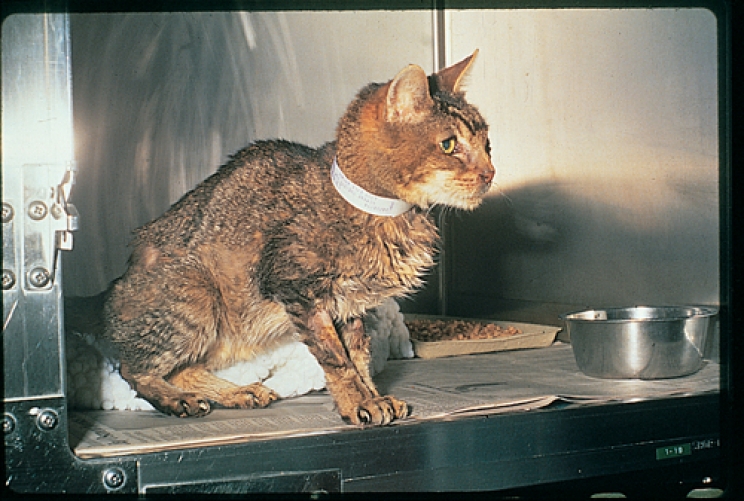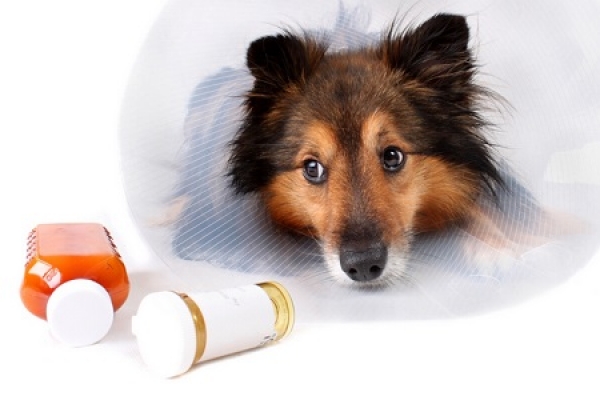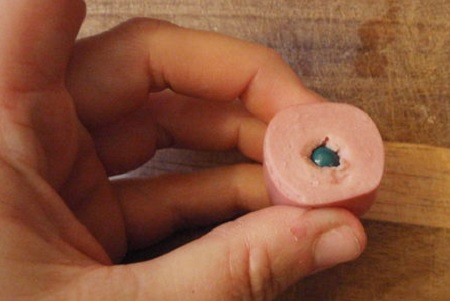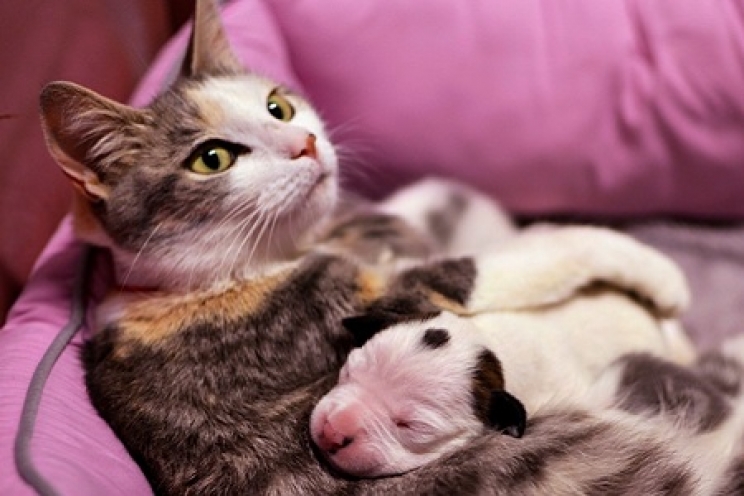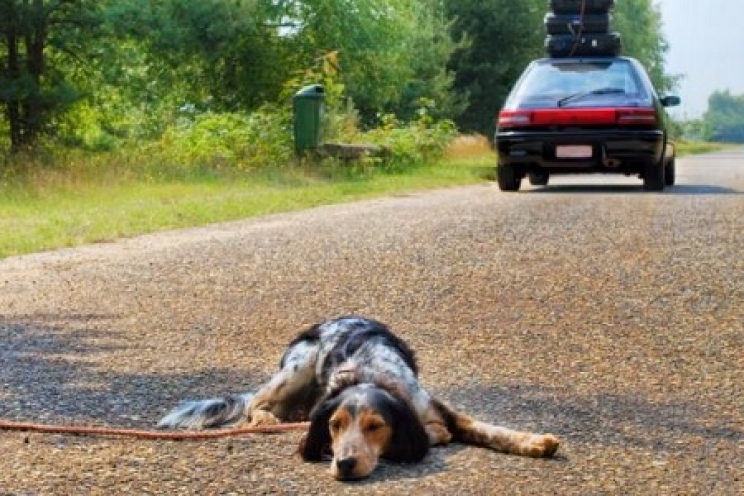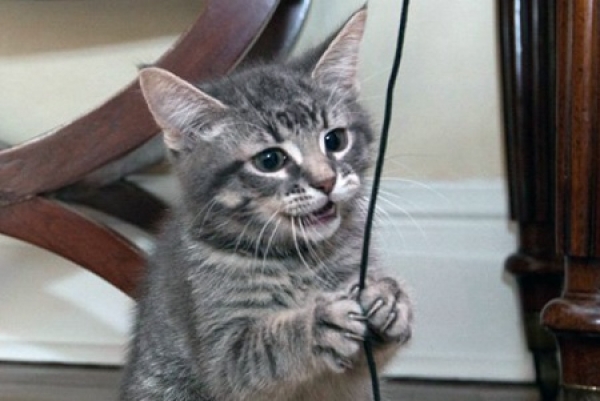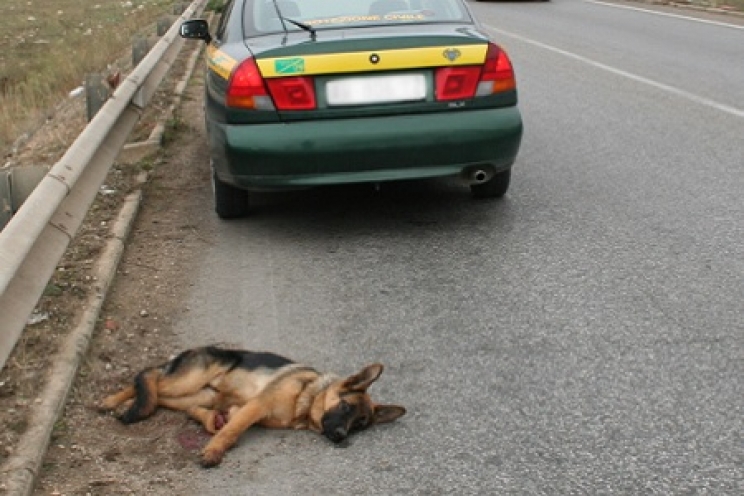Cats are much more likely than dogs to contract infectious diseases.
When your dog or cat needs daily care, it is not always necessary to take them to the vet every time, but you can also start learning the correct techniques to be able to administer the tablets yourself.
If your friend needs urgent therapy, (if your vet agrees) you can do it yourself, without wasting any more time.
Tablets are often prescribed for prolonged therapy, to be followed several times a day. In order to do this, it can be very useful to learn how to administer them yourself.
It is generally easier to give the tablets to dogs rather than cats. In fact, felines can be very cunning and shy, and they have a very demanding and suspicious palate. Dogs, on the other hand, are often clumsy, so it's easier to deceive them.
The technique of deception
The first method is precisely to insert the tablets into food by deceit. Choose your pet's favourite food and make sure that the tablet is well hidden inside. Dog owners usually prefer to use frankfurters or meatballs, or anything that is large enough to fit the tablets.
This technique works with most dogs, but with cats it may be more difficult.
Cats are very fussy on food choices and will immediately notice if you changed something in the usual food we give them. It will therefore immediately notice a smell that is not food and refuse to eat.
For cats, therefore, it might be a good idea to finely chop the tablet, mixing it with a baby food or their favourite food.
The "stuffed" syringe technique
If the deception technique does not work, you can try out a syringe without a needle, "stuffed" with baby food.
Finely chop the tablet and mix it with water at room temperature and with a little dissolved wet food. Try to make the solution liquid enough to pass through the syringe hole, but we do not recommend using just water as your pet could easily choke on it.
Hold the animal's head still with one hand and with the other place the syringe inside their mouth, in the free space immediately behind the canines. Slowly and gradually, push the baby food, waiting for the animal to swallow. Continue until all the mixture is finished.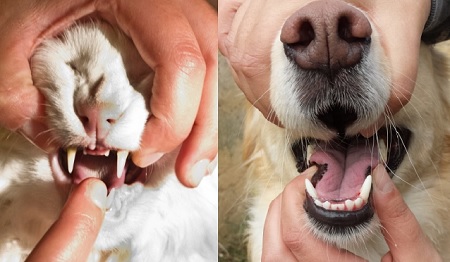
The hard way
If this doesn't seem to work either, you might want to use the hard way. It will be up to you to insert the tablet directly into the animal's mouth.
The procedure is slightly different for dogs and cats, due to the differences in anatomical conformation and personality. The cat scratches, but the dog bites, so you need to know how to defend yourself in both cases.
To give a cat a tablet, hold it with two fingers. With your left hand, hold their head on both sides. The index finger of the right hand must be inserted centrally on the incisors of the lower jaw, pushing it down (as shown in the picture of the cat). Once the cat has opened its mouth, insert the tablet on the tongue and push it deeply with the index finger.
To prevent the cat from spitting it out, try to force it by keeping mouth closed, using both hands and gently massaging the throat, to stimulate swallowing.
In dogs, however, the left hand holds the head still, with the middle and thumb on the sides of the jaw, being careful to cover the teeth with the skin, just behind the canines. This will prevent the dog from biting you. At the same time, the right hand grasps the lower part of the jaw, wrapping it with the palm of the hand and always with the same method; lower the jaw pushing the skin against the teeth.
We always proceed with a throat massage, to facilitate swallowing.
The Pill Shooter Technique
If you are not convinced or are afraid that your index finger will end up in the stomach of the pet, you can get yourself a pill shooter. This small plastic tool contains a special compartment for tablets and a kind of syringe, which allows you to reach the deepest part of the animal's mouth, inserting the tablet directly into the throat.
The moisturizer technique
For cats, you can also opt for another remedy, that is to spread the minced tablet on the hair, just as if you wanted to apply a moisturizer on him. Cats hate being dirty, so they will agree to lick the drug we applied on their skin in order to return clean and fragrant.
Finely chop the tablet and mix it with the usual hair remover paste or anchovy paste. Choose the one you prefer, as long as it is firm and sticky. Spread everything on the animal's paw or rub it around the muzzle.
The techniques to be able to administer the tablets to our animals are many. However, you will not always be able to put them into practice at the first try. After several attempts and rendered unusable tablets, wasted kilos of wurzel and various last scratch fights, you will probably have acquired the knowledge to make you real experts in administering tablets to dogs and cats.
Mastitis is a fairly common problem in female dogs and cats, especially during lactation, in the last period of pregnancy and even during phantom pregnancy. There are numerous treatments and remedies to prevent this from happening and to relieve the discomfort and pain generally associated with this problem.
First, it is good to clarify its meaning, before we can understand how to prevent it.
What is mastitis?
Mastitis is inflammation of the mammary gland. In most cases, the origin of the inflammation is of bacterial nature.
The mammary gland, in fact, is structured so that the milk can escape through the specific ducts and through the nipple. This means that, despite being deep inside the breast, the gland is in any case in contact with the external environment.
Many germs and bacteria are present on the tip of the nipple connected to the exterior, which in particular circumstances can easily go up through the nipple and its ducts, reaching the mammary gland.
Precisely for this reason, the risk factors that most frequently contributes to the onset of mastitis include above all:
- Insufficient hygienic conditions: this aspect is prevalent especially in stray animals. Cats or female dogs living on the street or in the countryside are often in contact with an environment full of bacteria. During pregnancy or breastfeeding, germs can contaminate the skin, easily reaching the mammary gland, where the infection is established;
- Presence of wounds or lesions on the skin of the breast: forcing puppies to remain still and calm is impossible. For this reason, mothers are often forced to endure scratches and bites inflicted by offspring during breastfeeding process. When the skin is not intact, the bacteria present in the environment can easily settle on the nipple, creating infections;
- Caesarean section: mastitis is more frequent in cats and in female dogs that have undergone a caesarean section. The area, in fact, is already affected by inflammatory processes typical of surgical wounds, so the risk bacterial contamination (normally present in the environment) increases. Furthermore, during breastfeeding, puppies can create injuries to the surgical wound, intensifying the inflammation, which can thus expand into the surrounding regions;
- Loss of puppies: if the puppies are removed from their mother too soon or if the birth is not successful, the milk produced by the mammary gland stagnates, favouring contamination by bacteria;
- Early weaning: puppies must stay with their mother as long as necessary to complete the lactation phase. If the babies were fed the typical weaning food before the expected age, they could lose interest in the mother's milk. This could thus accumulate in the breasts, where bacteria would immediately attack it;
- Systemic infections: if the mother has diseases acquired before or during pregnancy, the immune system may not be able to counteract the invasion of the mammary gland by germs;
- Depression: if the mother is depressed, the immune system becomes a reflection of it. Bacteria and viruses can attack the maternal organism undisturbed, increasing the risk of infection.
Symptoms of mastitis
In case of mastitis, the breasts appear swollen and red. When you touch them, they are hardened, hot and often painful. If the infection progresses, the localized inflammation of the mammary gland results in a real septic mastitis, with symptoms that affect the entire organism of the animal. Among these: fever, dejection, loss of appetite and lethargy.
Mastitis also involves very strong pain. The mother may decide to refuse breastfeeding and take care for the babies, sometimes even attacking them. Precisely for this reason, the risk that the puppies do not survive, especially if with a few days of life, is very high.
How to prevent it
It is practically impossible to expect the abdomen of our animals to remain perfectly clean. However, some tricks can be put into practice to reduce contamination by bacteria. For example:
- Try to keep the cat or dog with their babies in an isolated place in the house, preparing a cozy and easily accessible kennel;
- Always keep a clean blanket or sheet in the kennel, which you will change and wash often and regularly;
- Always clean the mother cat's litter box;
- Check that the skin of the breasts and abdomen is free from wounds;
- Prevent your pet from licking its udders. In case of pain, the temptation could be very strong, so always keep an eye on it;
- Feed your dog or cat with specific foods to promote efficient breastfeeding;
- Use warm water compresses on the breasts at least twice a day.
The most suitable treatment in case of mastitis involves the administration of antibiotics for a fairly prolonged period of time. In case of pain, your vet can recommend an anti-inflammatory that does not put the health of the little babies breastfeeding at risk.
As for breastfeeding, in milder cases, it should not be suspended at all. Instead, it should be encouraged with the use of specific food and supplements that stimulate the production and release of milk.
In severe cases, however, the infection may have reached such high levels as to irreparably compromise the hygiene of the milk. In case of important changes in the consistency or colour of the milk, or even traces of blood, it may be necessary to remove the babies from the mother and to proceed with an alternative feeding formula for the puppies and kittens.
In this article we will explain what to do and who to call when you find an abandoned animal on the street, in the countryside or on the highway.
The phenomenon of stray dogs is still current and present, and is constantly fueled above all by the increase of animal abandonment. In fact, there are many dogs and cats who often wonder aimlessly on the roadside, exposed to the constant risk of being hit by cars and trucks.
People's reactions on this issue are often mixed. A large portion of us would like to immediately get out of the car and run to save them, while others justify their carelessness with circumstantial phrases on the cruel laws of nature.
Both of these attitudes, however, are not good.
If you are in the country or in a field
If you are in town or in an easily accessible field, pull over and try to approach the animal very calmly. If he feels upset, he will not be able to trust you, especially if he is scared.
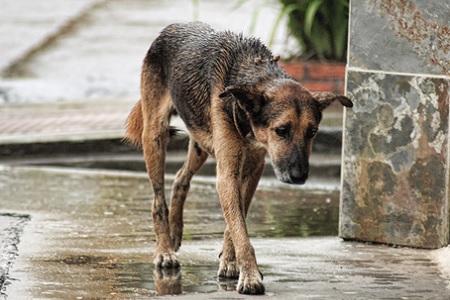
A terrified or defensive dog or cat could react by running away or attacking you, so in these cases stay around, but don't go beyond the safety distance set by him. If, on the other hand, the animal allows itself to be approached and seems quiet enough, offer him some water and food.
Take advantage of this to check if he has a collar with a medal.
In the meantime, you will need to contact the responsible authorities, i.e. the traffic police, zoophile guards or the relevant Veterinary Service in your area. Wait for their arrival together with the animal, then make sure it has been kept safe.
The rescue process requires the animal to be reported by the ASL Veterinary Service, which will contact the relevant kennel, to keep the animal for at least 10 days. In this period, it will be possible to assess whether the dog has a microchip, look for the possible owner and examine the state of health and its nature.
After this period, if you wish and have the possibility, you could choose to adopt it.
Always make sure that the animal does not have an owner. It would be sad to find out after you become attached to him. Fortunately, not all dogs and cats are necessarily abandoned, but they can also have escaped.
Share an announcement on social networks with a clearly visible photo of the animal, a brief description, the place of discovery and your telephone number, asking all your friends to spread the news. The associations and animal lovers will be happy to help you in this step. Compile leaflets with which to cover the country. It could in fact be a dog or cat of an elderly person or someone who is not interested in social networks.
Only after it has been verified that the animal has no owner, or that the owner has no intention of taking it back home, you can you start looking for a new accommodation. Even in this case, word of mouth on the web can do a lot, so rely on ads.
If the owner has been identified and it has been ascertained that the animal has been abandoned, immediately report it to the authorities, who will apply very heavy penalties.
If you are on a busy street
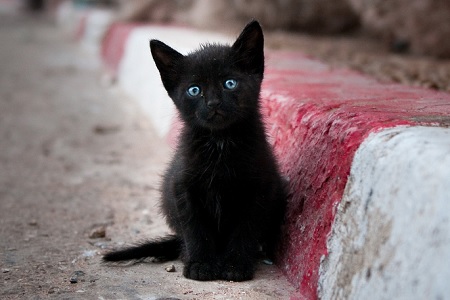
If you have spotted an animal in danger by the side of a busy road outside the town, you will have to behave differently.
Firstly, it is very important to clarify a fundamental aspect. You don't have to stop for any reason in the world. The temptation to leave the car at the first lay-by, put on a reflective vest and run to rescue him can be strong, but this would only put your life in danger.
Cars and trucks on high-speed roads will not have enough time to brake and dodge, so you could endanger both yourself and the animal you want to save.
What you have to do, however, is to stop further away from the busy road, take your mobile phone and immediately contact the competent authorities. Identify reference points to indicate the precise point of discovery. Check the number marked on the tag affixed to the guardrail.
In a short time, someone will be sent to the site, who will be able to determine if the animal is injured or just lost.
Now that you know how to behave, the next time you happen to see a dog or cat abandoned on the street, you can intervene in the right way and you can proudly claim to have saved it from a bad end.
Dogs and cats love to play with all the objects they can find at home, especially when they are small. Unfortunately, it can happen that the animal can ingest one of these toys and have some serious consequences. In this article, we will understand what dangers they face and what to do if the animal has ingested an object.
Why do animals eat objects?
Puppies and kittens up to 6 months of age do not have complete teeth. In fact, within the first two months, the milk teeth begin to erupt, which will be progressively replaced no earlier than 6 months.
When new teeth start to show up, animal can feel some discomfort in the gums, so they tend to chew on anything they find available. It is at this age, in fact, that puppies and kittens tend to gnaw and damage furniture in the house.
Animals can ingest objects by pure instinct. While playing, they can shatter and tear their toys, ingesting parts of them.
Dogs are considered big eye eaters of dolls and stuffed toys, while cats prefer ribbons, fabric threads, plastic and aluminium.
The ingestion of objects, however, can also occur due to the presence of behavioral disorders. The uncontrollable urge to ingest different types of inedible objects, is one of the obsessive-compulsive disorders. It occurs when you are too stressed, anxious or traumatized, so you divert your attention from your negative emotions towards a fixed action, which in this case is precisely the ingestion of objects.
What are the risks
The animal that ingests a foreign body, regardless of the type of material or size, is always exposed to risks. Of course, there are some particularly dangerous objects, such as larger and more pointed ones.
The consequences of the ingestion of objects by animals include:
- The object gets stuck in the mouth or between the teeth;
- The object gets stuck in the esophagus, stomach or intestine, causing a serious occlusion;
- The object pierces any point of the digestive tract, from the esophagus to the rectum;
- The object is also entangled in the respiratory system, causing suffocation;
- The object contains harmful substances that are released into the animal's body.
For this reason, it is very important to be able to understand what to do when we come across this event.
The most dangerous objects
Among the most dangerous objects that our animals can ingest we find above all:
- Balls
- Bottle caps
- Stuffed toy parts
- Stones
- Fruits big seeds
- Trash threads
- Twine
- Shoelaces
Cats are most attracted to anything a rat's tail can resemble. In addition, these are among the most harmful objects, because they can get entangled in the tongue and along the entire digestive tract, also increasing the risk of suffocation.
What should I do?
Avoid offering your pet potentially dangerous toys that are very small or have several detachable parts. Your children's soft toys are often not suitable for animals.
Try not to leave some common objects within reach of the animal that can attract them.
In addition, it may also be useful to carry out a regular count of the toys to make sure none are missing from the pile.
If you suspect your dog or cat has ingested an object, monitor it constantly. Check that he does not show any particular symptoms, such as vomiting, fever, fainting and loss of appetite.
Always check the cat litter box. As unhygienic as it may seem, you will have to analyze all dog or cat feces, looking for the ingested object.
If within twelve or twenty-four hours the animal has not yet eliminated the foreign body through its feces, take it immediately to the veterinarian, because it could be stuck in the stomach or intestines.
In these cases, action must be taken as soon as possible, because some situations can really endanger the animal's health and life.
Stray dogs and cats do not always manage to perceive the sense of danger, and unfortunately too often they become the victims of road accidents. On the side of the roads, bodies of animals run over and abandoned are found every day. Let's see what to do when we find an injured animal.
Unfortunately, there are still many people who still cannot become aware of this phenomenon, so these animals are often ignored and dismissed with a simple phrase, "it's their nature". Fortunately, there are also kind-hearted people who take care of mistreated dogs and cats.
However, it may happen that these people are not always informed about what tools are available to them to help animals in danger. So let's try to understand how to behave according to the situation in which you find yourself.
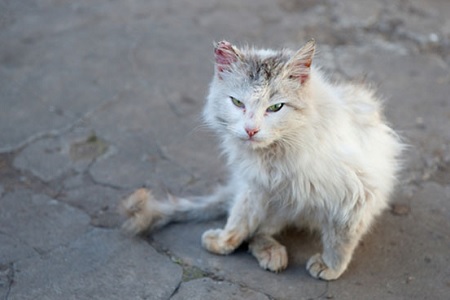
The animal is injured and tries to escape
It may happen that the dog or cat has an injured paw or a fractured limb. In this case, if they are very frightened, their instincts will lead them to run away, despite the pain and difficulty walking.
If you are in town or in any case in an area on the outskirts that you can reach without risk, try to approach it. Attract him with food and get some water.
Avoid running towards him and respect his conditions. A suspicious dog or cat may run away or attack you.
Try to stay calm by talking to him in a sweet tone of voice. Do not look at them straight in the eyes for too long and do not approach them directly. Rather, try to show yourself quite disinterested, while remaining around and if they get close, let yourself be smelled and resist the temptation to caress them.
In the meantime, call the competent local authorities, then the traffic police or the ASL Veterinary Service.
Stay with the animal until help arrives. Make sure he does not run away and that he does not get any more injuries trying to escape.
The animal is seriously injured
The greatest danger for stray animals is being run over. When you find a seriously injured dog or cat in the village or on an accessible road, or if the accident was accidentally caused by you, do not hesitate to help him.
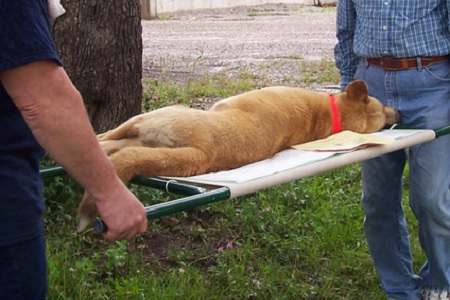
Immediately call a veterinarian who is willing to help injured animals on the street. For this reason, it is always useful to have a contact details of your veterinarian or whoever deals with these situations at hand.
Alternatively, you could take it directly to the nearest clinic. Transporting an injured animal is a very delicate operation, because in the case of fractures of the spine or other complex injuries, incorrect movement can worsen the situation.
In order to transport him to the vet, you will need to get an object that can serve as a stretcher. A cardboard, a plastic or wooden board, an old carpet, choose the one you have on hand, as long as it is stiff enough.
Gently lay the animal on the makeshift stretcher, paying great attention to perform slow and fluid movements. Avoid pulling or dragging it, as this will aggravate the injuries.
If you really have nothing, take him in your arms, trying to stretch him out.
It can happen that an injured cat is particularly alert and scared. In this case, it may be useful to get a towel or a blanket and wrap him around it so that it does not escape and does not try to scratch you.
Absolutely avoid offering him water or food, as he could have very serious injuries, for which immediate surgery is required. Wait until you reach the vet, who will take care of it.
The injured animal is on a road that is not accessible by feet
If you are on the motorway or on a road that is not intended for walking, do not stop. Rather, contact the competent law enforcement agencies, including the traffic police who will be able to act promptly to help the animal.
In fact, on roads, the risk of being run over is very high, so it would be useless to put your health at risk, when there are those who take care of it in the correct way.

